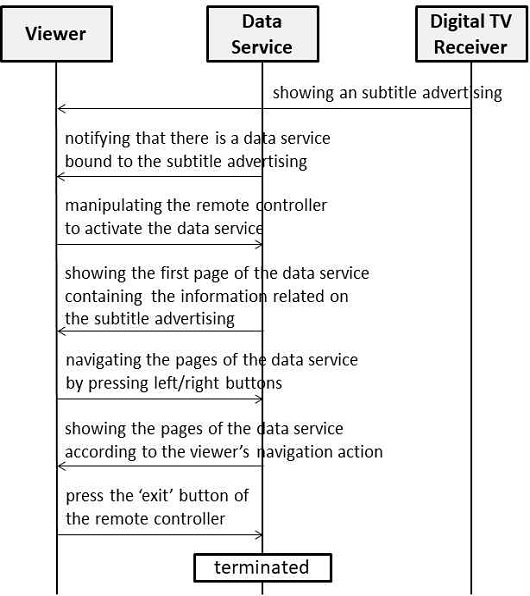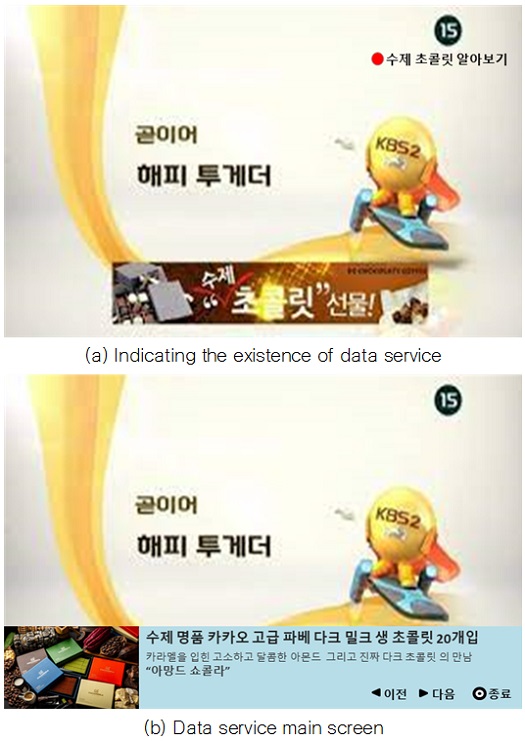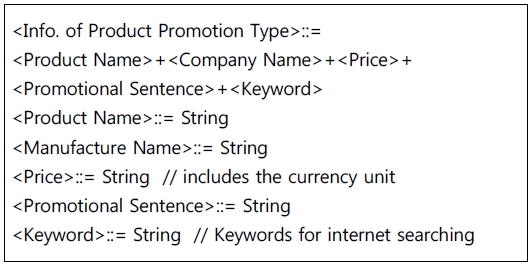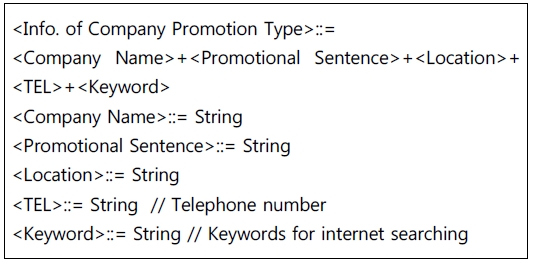
A Study on the Data Service linked to Subtitle Advertisement and its Advertisement Effectiveness
Copyright ⓒ 2021 The Digital Contents Society
This is an Open Access article distributed under the terms of the Creative Commons Attribution Non-CommercialLicense(http://creativecommons.org/licenses/by-nc/3.0/) which permits unrestricted non-commercial use, distribution, and reproduction in any medium, provided the original work is properly cited.

Abstract
The advertising market is an industrial field that is greatly affected by changes in media, and in particular, the broadcasting industry is on a continuous decline due to the emergence of online media. With the establishment of the digital broadcasting era, TV has developed into an active medium for executing various data services, which means that viewers' advertising consumption behavior can also actively change, so the broadcasting industry needs to consider a new advertising market growth strategy combining data services and advertisements. This study designed a data service that provides additional information of subtitle advertisements, which have serious limitations in exposure time and information expression space. Specifically, a user scenario and user interface of data service, and an additional information transmission method based on the international standard DVB for digital broadcasting were designed. Then the effect of using this data service on the effectiveness of subtitle advertisement was analyzed. In conclusion, the degree of understanding, liking, and imprinting of advertisements were statistically significantly higher.
초록
광고시장은 매체의 변화에 크게 영향을 받는 산업 분야로서 특히 방송 산업은 온라인 매체의 등장으로 광고시장이 지속해서 감소하는 추세에 있다. 디지털방송 시대가 정착되면서 TV가 다양한 데이터서비스를 실행할 수 있는 능동적 매체로 발전하였는데 이는 시청자의 광고 소비행태도 능동적으로 변할 수 있음을 의미하여 방송 산업은 데이터서비스와 광고를 결합한 새로운 광고시장 성장전략을 고민할 필요가 있다. 본 연구는 노출 시간과 정보 표현 공간에 심각한 한계가 있는 자막광고를 대상으로 광고의 부가정보를 제공하는 데이터서비스를 설계하였다. 구체적으로, 데이터서비스의 사용자 시나리오와 사용자인터페이스, 디지털방송 국제표준 DVB 기반의 부가정보 전송 방법을 설계하고, 데이터방송 국제표준 MHP 기반의 프로토타입을 개발하여 본 데이터서비스 활용이 자막광고 효과성에 미치는 영향을 분석하였다. 결론적으로 광고의 이해도, 호감도, 각인도 측면에서 통계적으로 유의미한 효과성을 확인할 수 있었다.
Keywords:
Broadcasting Advertisement Market, Data Service, Digital Broadcasting, Subtitle Advertisement, DVB-SI키워드:
방송 광고시장, 데이터서비스, 디지털방송, 자막광고, DVB-SIⅠ. Introduction
1-1 Research Background: Broadcast Advertising Market
Advertising can be defined as a form of non-face-to-face communication that uses mass media to persuade the audience [1]. In the broadcasting industry, there is an advertisement market in which consumers' access rights to advertisements are traded, and viewers can use broadcasting programs for free or at very low prices due to the profits of this advertisement market. The great advantage of broadcast advertising compared to other media is that it can effectively deliver advertising messages by using video and audio. By utilizing the advantages of such broadcast advertisements, messages can be delivered without damaging the product image, and consumers' product awareness can be maintained naturally [2].
According to the survey results of the Korea Online Advertising Association, broadcast advertising was found to be the most effective medium in terms of reliability, immersion, interest, and purchase decision making. Recently, as the consumption behavior of purchasing products after comparing cost-effectiveness through acquisition of information is spreading, broadcasting advertisements are lagging behind online advertisements such as personal computers and mobile advertisements in terms of mutual compatibility and sales linkage [3].
As a result, the size of the broadcast advertising market in 2020 is estimated to be Korean Won (KRW) 3.557 trillion, a decrease of 5.7% from the previous year. In particular, the sales of terrestrial broadcast advertisements decreased by 6.4% compared to the previous year to KRW 1.16 trillion, exceeding the average rate of decline in the broadcast advertisement market (See Table 1)[4]. Such a situation is an urgent problem for broadcasters whose advertising revenue accounts for a significant portion of their sales.
As a clue to solving the problem, it can be considered that TV, which was a typical passive media medium, has evolved into a smart TV that supports application (data service) execution and Internet environment as digital broadcasting technology is introduced. With the advent of smart TV, the passive TV viewing behavior gradually changed to an active one, which means that the consumption behavior of broadcast advertisements can also be actively changed. Therefore, it can be said that the broadcasting industry, which has provided broadcasting programs for free or at low cost through advertisements, needs a growth strategy that expands the success stories of data service, which has been shown in cases such as Video On Demand (VOD) and Electronic Program Guide (EPG), to the advertisement market.
1-2 Research Subject and Outline
This study designed a data service that provides additional information related to advertisements to viewers for subtitle advertisements, one of the types of broadcast advertisements. Subtitle advertisements are divided into 'Soon' advertisements and Identification (ID) advertisements. Soon advertisements refer to advertisements in the form of images that are displayed when announcing the next broadcast program. ID advertisements are advertisements in the form of images that are displayed when the name of a broadcasting station is output. (See Figure 1)
Subtitle advertisements have the advantage of being cheaper than general broadcasting advertisements composed of video and audio. However, subtitle advertisements have a weakness in that they cannot contain necessary information due to the temporal constraint that the exposure time is quite short (less than 10 seconds) and the spatial constraint that the size of the subtitles does not exceed a quarter of the TV screen.
In order to overcome the temporal and spatial limitations of subtitle advertisement, this study designed a data service that provides additional information related to subtitle advertisement. Specifically, the representative advertisement types of subtitle advertisements and main additional information for each type are formally defined, and a method of transmitting the additional information using the DVB (Digital Video Broadcasting) [5] and SI (Service Information) protocol [6], an international digital broadcasting standard, was designed. In addition, based on the contents of this study, a data service prototype based on DVB-MHP (Multimedia Home Platform) [7], an international standard for data broadcasting, was developed and the effect of using this data service prototype on the effect of subtitle advertisement was analyzed for 61 university students.
This study is meaningful in that it solves the temporal and spatial constraints of subtitle advertisements by using data services and presents new possibilities for revitalizing the broadcasting advertisement market in a situation where the broadcasting advertisement market is continuously shrinking.
Ⅱ. Subtitle Advertisement Linked Data Service
2-1 User Scenario and User Interface
A typical user scenario of this data service is as follows. (1) First, the data service displays a message on the TV screen notifying that there is a data service linked to the current subtitle advertisement when the subtitle advertisement is exposed. In case of the research, the data service outputs a notice that the data service is executed when the red button on the remote control is pressed. (2) If the viewer presses the red button on the remote control within the subtitle advertisement time (up to 10 seconds), the data service is executed and the main screen is displayed. The main screen is composed of the additional information of the subtitle advertisement. The contents of the information can be designed in various ways according to the needs of broadcasters and advertisers. (3) The viewer can terminate the data service by pressing the exit button on the remote control. The data service was designed not to automatically terminate even after the time of subtitle advertisement has elapsed, thereby avoiding a negative user experience due to unintentional termination. (See Figure 2)
Based on the study of [8], the data service’s user interface was designed so that the output screen does not exceed one-third of the TV screen and data service can be used only with the left, right and exit buttons of the remote control. This design takes into account that the main purpose of TV usage is to watch broadcasting programs, and reflects the characteristic that the remote control is generally inconvenient for data service operation. Figure 3 shows the structure of this data service user interface. Figure 3-(a) shows that the data service can be executed by pressing the red button on the remote control while the subtitle advertisement is being displayed.
Figure 3-(b) is the main screen of data service and provides appropriate information according to the type of advertisement target (e.g. product advertisement, company promotion, etc.). Information related to data service operation is displayed in the lower right corner of the screen.
2-2 Additional Information Type Definition
Subtitle ads have a time limit of up to 10 seconds, so the data service must efficiently show the core content according to the advertisement target. For this purpose, this study divided the types of subtitle advertisement into 'product advertisement type' and 'company promotion type' as a pilot, and defined the main information for each type as follows. Advertisers and broadcasters can expand their advertising targets by defining new types of advertisements based on this study.
The advertisement target of the product advertisement type includes various products from electronic products, food and beverages, as well as travel products. In this study, the main additional information of the product advertisement type was defined as product name, manufacturer name, promotional text, price information, and the internet search keywords that can obtain detailed information. (See Figure 4)
The advertisement target of the company promotion type can be a company, a government agency, a university, or a local government, and it has the purpose of raising brand image by exposing one's own existence. In this study, major additional information of company promotion type was defined as company name, promotional text, location, contact information, and Internet search keywords. (See Figure 5)
2-3 Data Service Information Supply Method
Additional information of subtitle advertisement is supplied to data service using SI protocols defined by DVB, international standard for digital broadcasting. SI is a protocol defined in the form of a table for transmitting additional information related to a broadcast network, a channel, a broadcast program, etc., and defines various tables according to the purpose of the additional information. A broadcasting station or service provider can describe arbitrary information in a protocol called 'Descriptor'. Then, this descriptor can be stored in an appropriate SI table and delivered to the digital TV receiver.
Considering the limitation that the exposure time of subtitle advertisement is quite short, this study designed a method to provide data service by loading descriptors containing additional information of subtitle advertisement in EIT-P (Event Information Table-Present). EIT-P is an SI table used to transmit additional information of a currently broadcast program. It is suitable for transmitting information that needs to be time-sensitively interlocked with a broadcasting program due to the characteristic that it is repeatedly transmitted in a short period (generally within 500ms). Table 2 and Table 3 define the descriptors to contain additional information of product advertisement type and company promotion type subtitle advertisement, respectively.
Ⅲ. Data Service Effectiveness Analysis
3-1 Experimental Method
In order to experimentally analyze the effect of this data service on the effect of subtitle advertisement, a prototype of data service was developed. The prototype of this data service was produced with ‘altiComposer’[9], a data service authoring tool based on the international standard MHP for data broadcasting.alti Composer supports WYSIWYG data service development and provides a function to automatically generate executable code in MHP middleware.
Using the prototype, an experiment was conducted with 61 college students. Experimental subjects were divided into two groups. Group-A consisted of 31 people, and the prototype of this data service was used when watching subtitle advertisements. Group-B consisted of 30 people and had them watch the subtitle advertisement in a typical way without data service. After watching the subtitled advertisement, a survey was conducted with the items shown in Table 4 to measure the effectiveness of the advertisement for each group. The answers to the questionnaire items were composed of a 5-point scale of ‘Likerttechniqu’, and IBM SPSS Statics was used to analyze the survey results.
3-2 Experimental Results and Analysis
The members of group-A and group-B do not overlap, and since both groups have never experienced this data service before, it can be assumed that they are mutually independent. The effectiveness of this data service was analyzed by performing the t-test, which is commonly used to analyze whether the mean of two independent groups is statistically significant.
Table 5 summarizes the analysis results of the t-test for each questionnaire item on the effectiveness of subtitle advertisements. Regarding the degree of <Understanding>, Group-A (M=4.19) answered that their understanding of subtitle advertisement content was increased in a statistically significant way compared to Group-B (M=2.13). As for the <Favorite>, Group-A (M=4.29) said that they liked the subtitle advertisement statistically significantly compared to Group-B (M=2.20). Finally, for <Engraving>, Group-A (M=4.69) answered that the content of the subtitle advertisement was impressive compared to Group-B (M=3.61) in a statistically significant way.

t-test Analysis of the Questionnaire Result on the Effectiveness of Subtitle Advertisements in Group-A and Group-B
The above experimental results imply that viewers' interest in subtitle advertisements is not improved just by the presence of data services when subtitle advertisements are exposed. However, once the data service is used, the additional information provided by the data service improves the understanding of the advertisement target, and it can be interpreted that this understanding led to the improvement of the favorability and engraving degree. Such analysis results suggest that, in addition to notifying the existence of data services at the time of exposure of subtitle advertisements, there is a need for an element to induce viewers to execute data services.
Ⅳ. Conclusion
With the development of digital technology, TV, a passive medium, has developed into an active one through Internet use and application (data service) operation. Amid these changes, the broadcasting industry needs to consider a new growth strategy to expand the application of data services to the broadcasting advertising market. In this context, this study designed a data service that provides additional information for subtitle advertisements, which have limitations in terms of short exposure time and lack of information expression space. Specifically, user scenarios, user interfaces, and additional information for each type of advertisement target were designed. In addition, a method of supplying additional information to data services was developed based on international digital broadcasting standards.
In addition, a prototype of the data service was developed to analyze the effect of the use of the data service on the subtitle advertisement effect. 61 college students were divided into Group-A (Data Service Use, 31 students) and Group-B (Data Service Unuse, 30 students) and surveyed on the effectiveness of subtitle advertisements. As a result of the survey, there was no statistically significant difference in the degree of interest in subtitle advertisements, but Group-A scored statistically significantly higher than Group-B for understanding, favorability, and imprinting of subtitle advertisements. In conclusion, it can be seen that combining data service with subtitle advertisement improves advertisement effect. Therefore, broadcasting companies are expected to increase the size of the broadcasting advertisement market by using data services for subtitle advertisements.
This study has a limitation that the subjects are limited to college students. This is because this study has the nature of a "feasibility study" that includes data service design to data service effectiveness analysis, and college students who are relatively advantageous in conducting the experiment were selected as subjects. Despite these limitations, this study is meaningful in that it first tested the effectiveness of subtitle advertisements that occur when combining subtitle broadcasting and data services and presents a new direction for revitalizing the broadcasting advertisement market.
Acknowledgments
This research is based on the support of 『2021 Woosong University Academic Research Funding』
References
- Korea Advertising Society Home Page: http://www.koads.or.kr
- Yongho Bae, The case study on the emotional marketing of enterprise : focused on broadcasting advertising, MS Thesis, Kongju University, 2013.
- Yoon-Jeong Na and et. al., “Research and Analysis on Online Advertising Industry Trend,” research and analysis, Korea Internet & Security Agency, Dec. 2016.
- “2020 Korea Communications Advertising Expense Survey Report,” Korea Broadcasting Advertising Promotion Corporation, Dec. 2020.
- “ETSI EN 301 192 v1.4.2: DVB specification for data broadcasting,” ETSI, DVB, 2008.
- "Digital Video Broadcasting (DVB): Specification for Service Information (SI) in DVB systems,” ETSI, DVB, 2004.
- “ETSI TS 102 543 v1.1.1: Digital Video Broadcasting (DVB); Globally Executable MHP (GEM) Specification 1.2," ETSI, DVB, 2008.
- Kwangil KO, “A TV Viewer's Modality-based Searching System Designed for Running on TV Set,” The Journal of Digital Contents Society, Vol. 11, No. 3, 2010.
- altiComposer 2.0–Interactive TV Authoring Tool: https://www.digitalbroadcasting.com/doc/alticast-launches-interactive-tv-authoring-to-0001

1995년 : 포항공과대학교 전자계산학과 (학사, 석사)
1999년 : 포항공과대학교 컴퓨터공학과 (공학박사)
1999년~2010년 8월: (주)알티캐스트 사업품질관리본부 본부장 및 서비스개발사업팀 팀장
2010년 9월~현 재: 우송대학교 테크노미디어융합학부 미디어디자인·영상전공 교수
※관심분야:디지털방송 소프트웨어, 스마트TV방송UI/UX, 소프트웨어공학, 요구분석공학, N-스크린 서비스, 소프트웨어 교육




